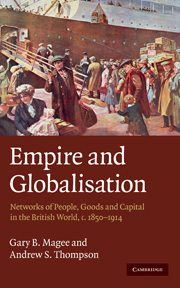Book contents
4 - Markets and consumer cultures
Published online by Cambridge University Press: 05 June 2012
Summary
Introduction
This chapter explores a key feature of late-nineteenth and early-twentieth-century globalisation, namely the emergence of the empire's settler societies as the fastest-growing export market for the British ‘metropole’. Not only did these colonies consume comparatively high levels of British exports, the share of income they devoted to British goods also deepened relative to other parts of the developed and developing world over time. The latter is an intriguing fact with implications for how we perceive the evolution of colonial consumer behaviour prior to the First World War. Most importantly, it suggests a quickening of economic relationships within the British World at this time: a more precise and intensive drawing together of the interests and needs of Britain and its settler colonies. Migrant consumers, it seems, were becoming more, not less, wedded to the British product, as other competing uses for their income, such as the consumption of local or foreign (non-British) goods and services, became available to them. Why, then, did British products fare so well in these markets, and why did colonial consumers, by that time free to buy from anyone in the international marketplace, spend such a large share of their income on them?
We argue that a good part of the answer lies in the rich and layered interconnections that characterised the British World – the ethnic and cultural ties that bound settlers emotionally, financially and spiritually to ‘home’.
- Type
- Chapter
- Information
- Empire and GlobalisationNetworks of People, Goods and Capital in the British World, c.1850–1914, pp. 117 - 169Publisher: Cambridge University PressPrint publication year: 2010

